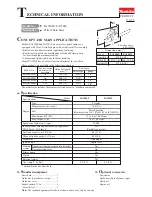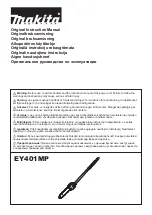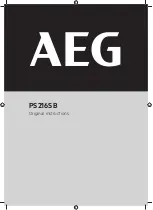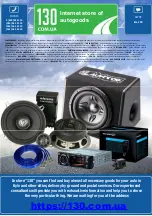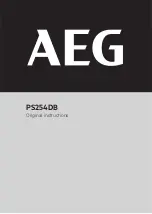
English
18
5) Service
a)
Have your power tool serviced by a qualified repair person
using only identical replacement parts.
This will ensure that
the safety of the power tool is maintained.
2. Safety instructions for all saws
a)
DANGER: Keep hands away from cutting area and the
blade. Keep your second hand on auxiliary handle, or mo-
tor housing.
If both hands are holding the saw, they cannot
be cut by the blade.
b)
Do not reach underneath the workpiece.
The guard cannot
protect you from the blade below the workpiece.
c)
Adjust the cutting depth to the thickness of the workpiece.
Less than a full tooth of the blade teeth should be visible be-
low the workpiece.
d)
Never hold piece being cut in your hands or across your leg.
Secure the workpiece to a stable platform.
It is important to
support the work properly to minimize body exposure, blade
binding, or loss of control.
e)
Hold power tool by insulated gripping surfaces when per-
forming an operation where the cutting tool may contact
hidden wiring or its own cord.
Contact with a „live“ wire will
also make exposed metal parts of the power tool „live“ and
shock the operator.
f)
When ripping always use a rip fence or straight edge guide.
This improves the accuracy of cut and reduces the chance of
blade binding.
g)
Always use blades with correct size and shape (diamond
versus round) of arbour holes.
Blades that do not match the
mounting hardware of the saw will run eccentrically, causing
loss of control.
h)
Never use damaged or incorrect blade washers or bolt.
The
blade washers and boltwere specially designed for your saw,
for optimum performance and safety of operation.
3 Further safety instructions for all
saws
Causes and operator prevention of kickback:
– kickback is a sudden reaction to a pinched, bound or mis-
aligned saw blade, causing an uncontrolled saw to lift up and
out of the workpiece toward the operator;
– when the blade is pinched or bound tightly by the kerf closing
down, the blade stalls and the motor reaction drives the unit
rapidly back toward the operator;
– if the blade becomes twisted or misaligned in the cut, the
teeth at the back edge of the blade can dig into the top sur-
face of the wood causing the blade to climb out of the kerf
and jump back toward the operator.
Kickback is the result of saw misuse and/or incorrect operat-
ing procedures or conditions and can be avoided by taking
proper precautions as given below.
a)
Maintain a firm grip with both hands on the saw and po-
sition your arms to resist kickback forces. Position your
body to either side of the blade, but not in line with the
blade.
Kickback could cause the saw to jump backwards, but
kickback forces can be controlled by the operator, if proper
precautions are taken.
b)
When blade is binding, or when interrupting a cut for any
reason, release the trigger and hold the saw motionless
in the material until the blade comes to a complete stop.
Never attempt to remove the saw from the work or pull the
saw backward while the blade is in motion or kickback may
occur.
Investigate and take corrective actions to eliminate the
cause of blade binding.
c)
When restarting a saw in the workpiece, centre the saw
blade in the kerf and check that saw teeth are not engaged
into the material.
If saw blade is binding, it may walk up or
kickback from the workpiece as the saw is restarted.
d)
Support large panels to minimise the risk of blade pinch-
ing and kickback.
Large panels tend to sag under their own
weight. Supports must be placed under the panel on both
sides, near the line of cut and near the edge of the panel.
e)
Do not use dull or damaged blades.
Unsharpened or im-
properly set blades produce narrow kerf causing excessive
friction, blade binding and kickback.
f)
Blade depth and bevel adjusting locking levers must be
tight and secure before making cut.
If blade adjustment
shifts while cutting, it may cause binding and kickback.
g)
Use extra caution when making a „plunge cut“ into exist-
ing walls or other blind areas.
The protruding blade may cut
objects that can cause kickback.
4 Safety instructions for saws with
lower quard
a)
Check lower guard for proper closing before each use. Do
not operate the saw if lower guard does not move freely
and close instantly. Never clamp or tie the lower guard
into the open position.
If saw is accidentally dropped, lower
guard may be bent. Raise the tower guard with the retracting
handle and make sure it moves freely and does not touch the
blade or any other part, in all angles and depths of cut.
b)
Check the operation of the lower guard spring. If the guard
and the spring are not operating properly, they must be
serviced before use.
Lower guard may operate sluggishly
due to damaged parts, gummy deposits, or a build-up of
debris.
c)
Lower guard may be retracted manually only for special
cuts such as „plunge cuts“ and „compound cuts.“ Raise low-
er guard by retracting handle and as soon as blade enters
the material, the lower guard must be released.
For all oth-
er sawing, the lower guard should operate automatically.
d)
Always observe that the lower guard is covering the blade
before placing saw down on bench or floor.
An unprotected,
coasting blade will cause the saw to walk backwards, cutting
whatever is in its path. Be aware of the time it takes for the
blade to stop after switch is released.
4.1 Further safety instructions
– Check the plug and cable on a regular basis and, if they are
damaged, have them replaced by an authorised customer
service workshop.
– The switch must be in the OFF position before you connect it
to the mains.
– Always guide the power cable from the tool to the rear. Never
pull hard on the power cable and never place it on or guide it
over any sharp edges.
– Only work in a safe and stable position.
– Do not work in damp environments.
–
Wear suitable personal protective equipment:
Ear protec-
tion, protective goggles, dust mask for work that generates
dust and protective gloves when changing tools, sturdy
shoes.
4.2 Other risks
Even in cases where the machine is used correctly and all rele-
vant safety instructions have been adhered to, the design engi-
neering of the machine and its operation mean that the follow-
ing safety risks may also arise:
– Danger caused by the power cable.
– A concentration of dust which is harmful to health when
working in an area that is not sufficiently ventilated.
– Injuries caused by touching electrified parts when removing
the machine or its parts if the plugs on the power cable have
not been removed from the socket.
– You must only use original spare parts.
Summary of Contents for EPK 18
Page 5: ...5 2 10 12a 12b 12c 13a 13a 13b 14a 14b 14c 14d 17 12d 12c...
Page 11: ...esky 11...
Page 33: ...En espa ol 33...































